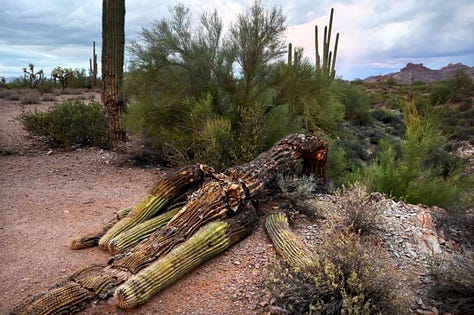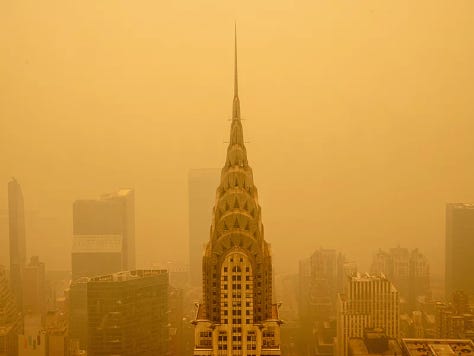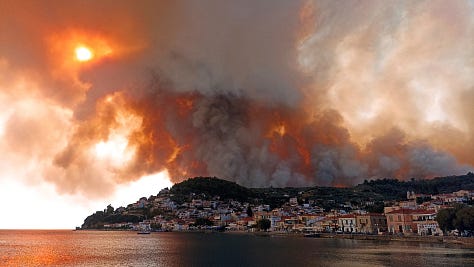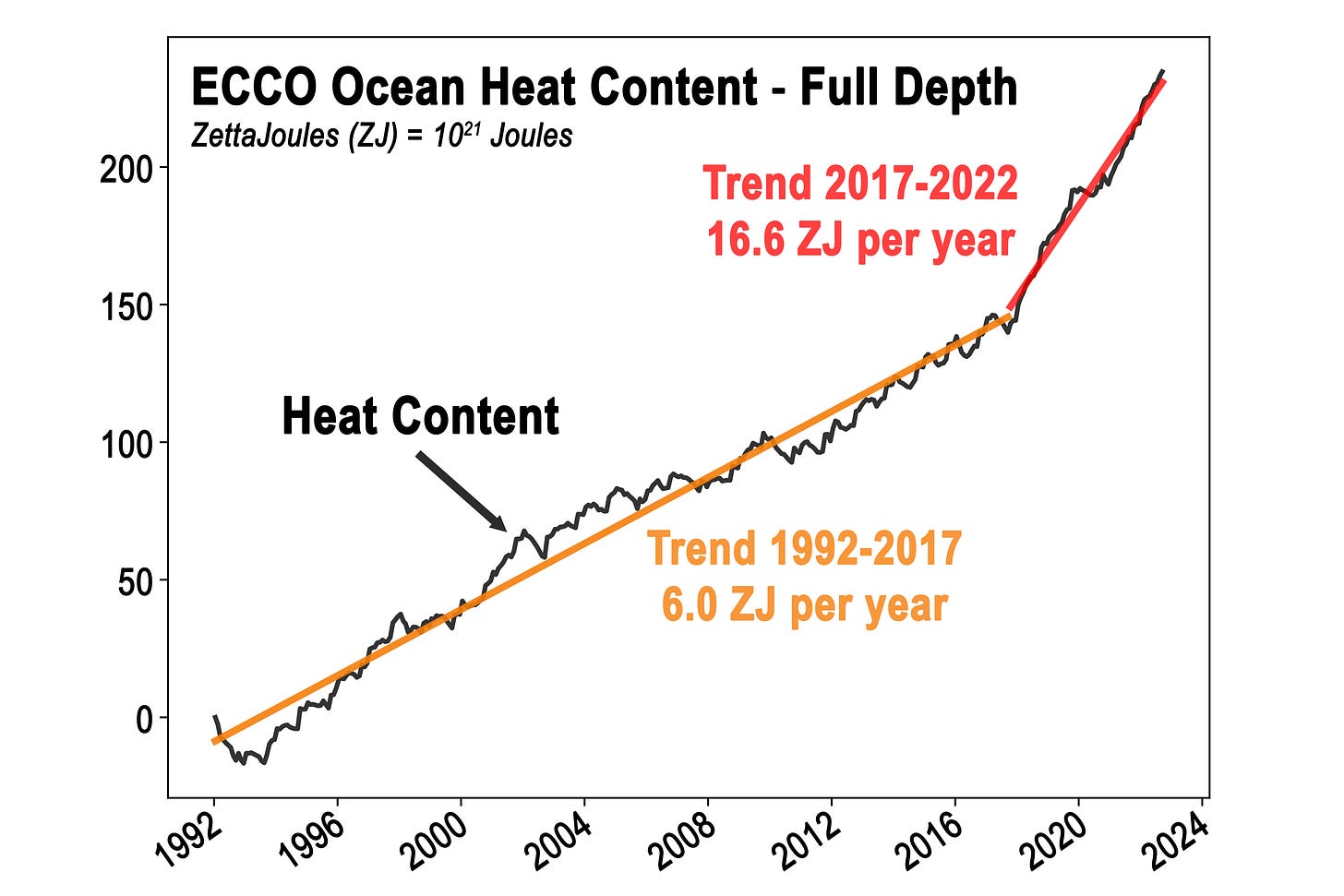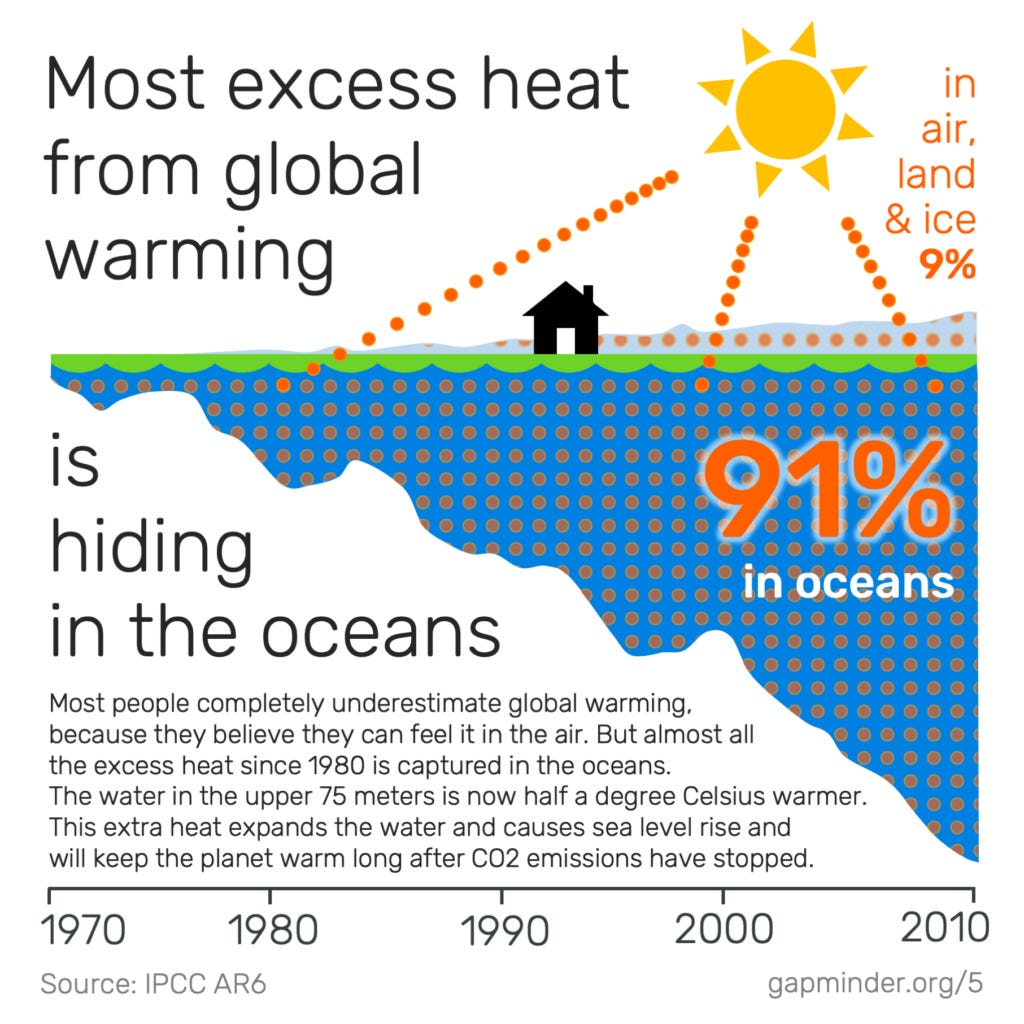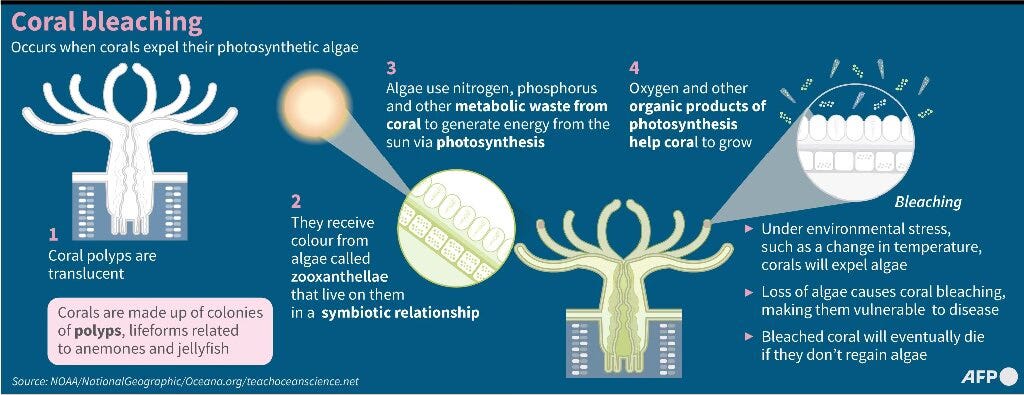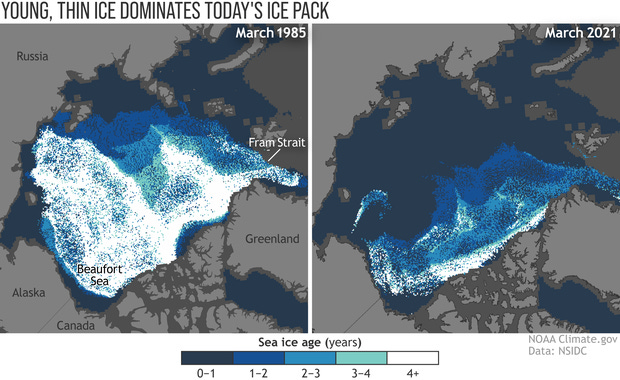In Posts 3.1, 3.2 and 3.3, we’ll survey the impacts of Development Culture, which started as flare-ups of “civilized” societies dating back to 10,000 BC Mesopotamia, and has now metastasized into a global affliction.
this post is intentionally link-heavy!
for weekly updates on everything everywhere falling apart, I recommend the user “Last Week in Collapse”. Here’s their history of weekly posts on Reddit & for a weekly newsletter delivered to your email inbox, their Substack
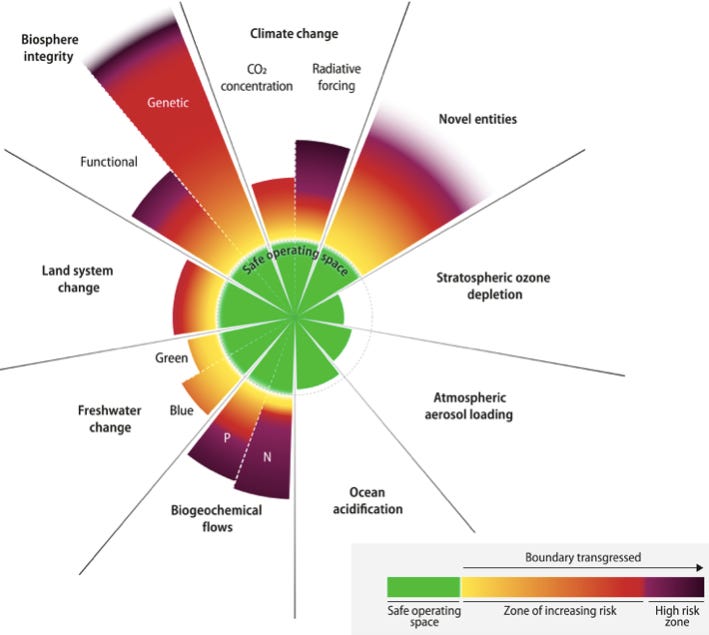
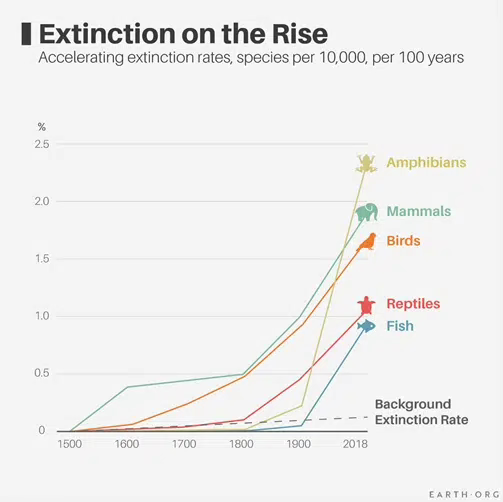
“Biosphere Integrity Loss”
(among the 3 most-threatened Planetary Boundaries)
We are currently experiencing a Sixth Mass Extinction. The World Wildlife Fund estimates that between 200 and 2,000 extinctions occur every year. The current rate of extinction is between 100 and 1,000 times higher than the pre-human background rate of extinction.
Humans have been killing off fellow vertebrates (whether directly or indirectly) in remarkable numbers since before the industrial era - it’s a civilization/ resource appetite problem, not just climate change problem.
69% wildlife population die-off from 1970-2020, true of insects too
2024: “Humanity is on the verge of ‘shattering Earth’s natural limits’, say experts in biodiversity warning” … & “biodiversity loss declining faster in ‘protected’ areas”
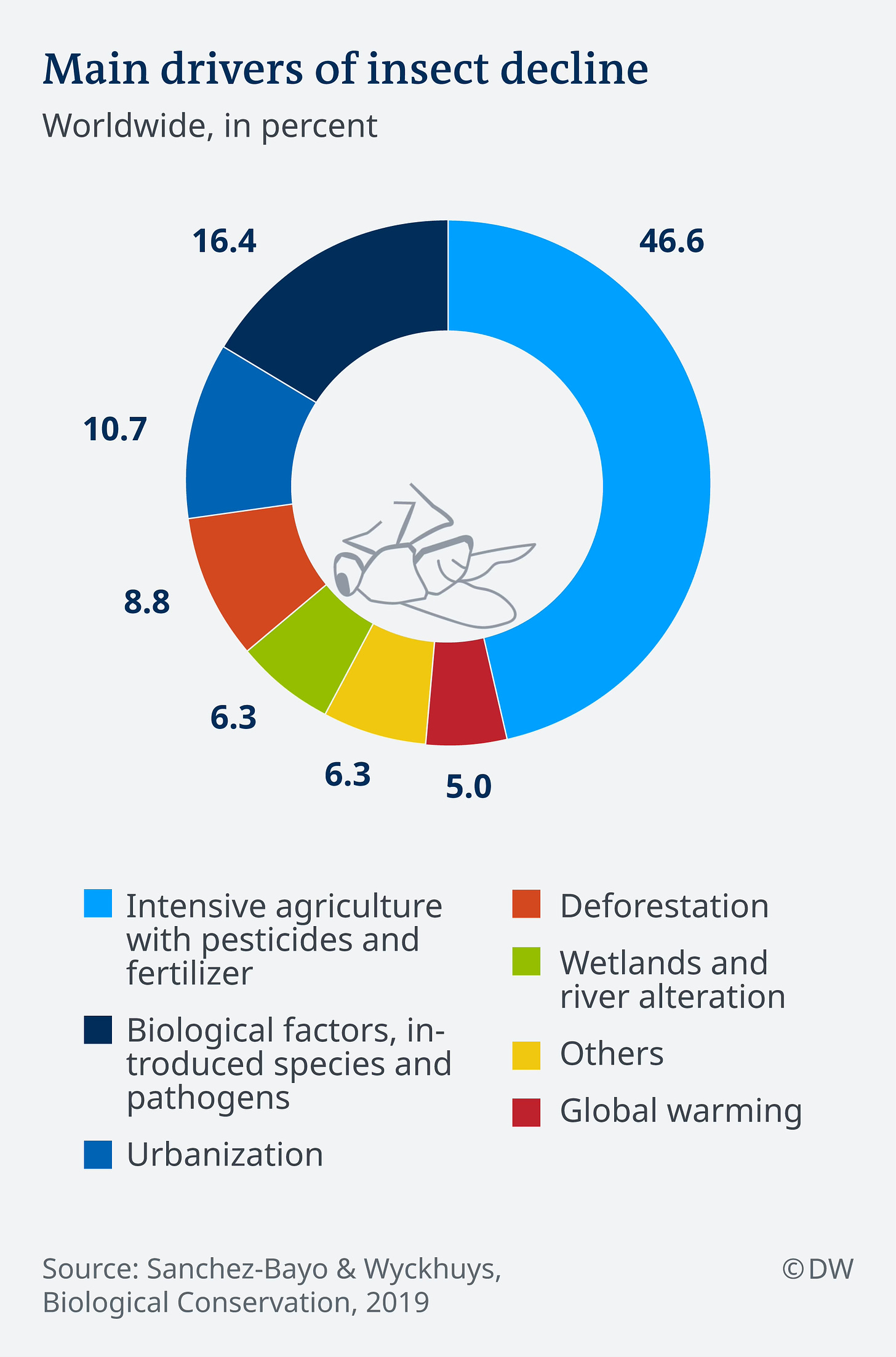
2019 heat wave killed 23,000 bats
2022 Alaska marine heatwave caused billions of snow crabs to starve to death
2022 heatwave/dehydration caused birds to fall from the sky in India
2023 ice melt led thousands of baby penguins to drown/freeze to death
2023 declining salmon population means grizzly bears are starving to death
2023 heatwave/dehydration killed elephants in Zimbabw
2024 extreme heat in Thailand is causing ducks to lay fewer eggs
2024 extreme heat in Mexico is causing monkeys to fall dead from trees
2024 heat is killing moose calves in Norway (“they need to spend more energy keeping their body temperature down - energy that could be spent on the immune system, or putting on fat to survive the winter”)
2024 warming snow is causing “lacerations, hair loss, ice buildup and skin ulcerations” on polar bears’ feet
In a hotter climate, dung beetles struggle to dig deep enough to shelter their offspring. As the dung beetle population drops…
soil will be less aerated and nutrient-rich, impacting agriculture
manure will release methane, which traps even more heat than carbon dioxide (80x as much in the first 20 years)
feces and carrion will sit and decay, spreading disease
“Climate change is warping the seasons” -
“Insects that are used to feasting on April-flowering plants may find themselves arriving a month late if warmer temperatures mean that the plants now flower in March”
“Caterpillars are emerging earlier than they did in the past, and the birds that eat them can’t keep up. ‘For every ten-day advance in caterpillar emergence, the birds are only able to bring forward their egg laying by three to five days‘“
“Some species will delay hibernation and emerge in spring sooner, but others will stick to their original schedule, taking their cues from day length rather than temperature. The result will be chaos”
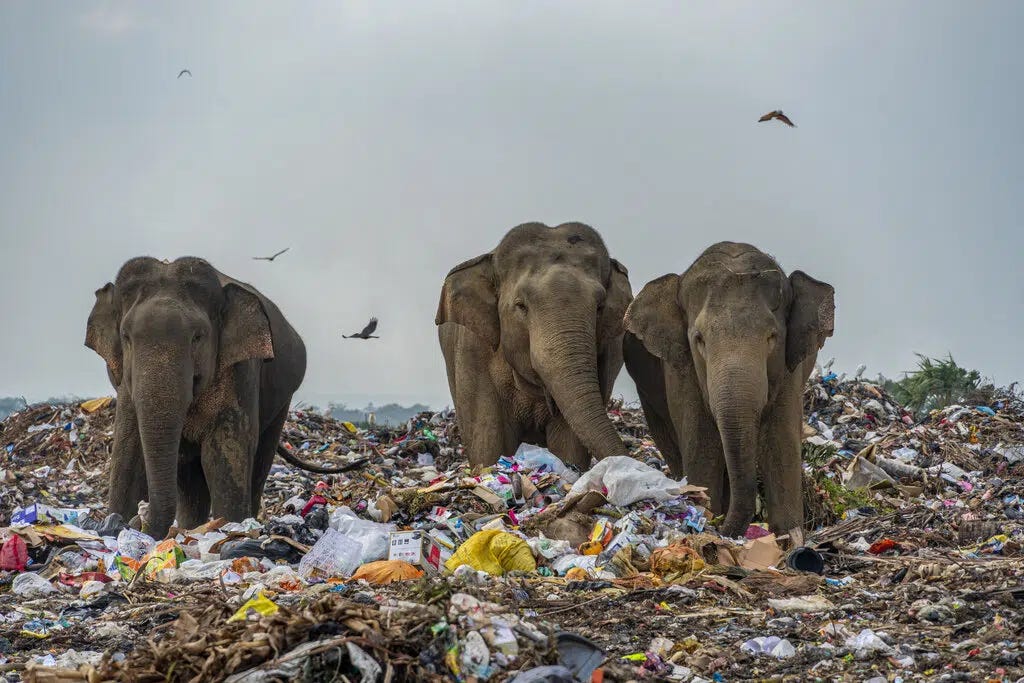
“Novel Entities”
(among the 3 most-threatened Planetary Boundaries)
From The Guardian:
“From brown trout becoming ‘addicted’ to methamphetamine to European perch losing their fear of predators due to depression medication, scientists warn that modern pharmaceutical and illegal drug pollution is becoming a growing threat to wildlife... Female starlings dosed with antidepressants such as Prozac at concentrations found in sewage waterways become less attractive to potential mates... The contraceptive pill has caused sex reversal in some fish populations – leading to a collapse in numbers and local extinction events”
India’s vulture population in the 1980s was 40,000,000. In the 1990s, they gave diclofenac to livestock. This made its way into vultures’ systems, causing lethal kidney failure. In 2006, India banned diclofenac, but as of 2017, the vulture population is still only 19,000 (0.05% of what it had been). Without abundant vultures, garbage, excrement and carrion built up. During 2000-2005, the excrement and carrion that built up in the vultures’ absence can be tied to 100,000 extra human deaths from disease. India’s feral dogs, who no longer had to compete with as many vultures, saw their population increase by at least 5,000,000, leading to over 47,000 extra human deaths from rabies.
And a study concluded that “pesticides penetrate the peel layer into the pulp layer” of produce, so even if you wash industrially-farmed fruits and veggies, you’ll still ingest the chemicals
Microplastics have been discovered in … clouds, rain, an Antarctic glacier, tap water, soil deposits 23 feet deep, and most food (including organic produce) … Toxins from some microplastics can be absorbed through skin
They’ve made their way into our… testes and sperm, placentae, breastmilk, lungs, livers, kidneys and brains, knee and elbow joints, blood vessels and bone marrow, blood
Once inside organisms, they:
are causing 10% of premature births (2024)
increase risk of dementia and Alzheimers (“researchers looked at 12 brain samples from people who had died with dementia, including Alzheimer’s disease. These brains contained up to 10 times more plastic by weight than healthy samples”)
precipitate falling sperm counts which, at the current rate, around midcentury would result in effectively-universal human infertility (in a study of 23 human and 47 canine testicles, human testes had almost 3x the plastic concentration of dogs’)
A study of 3000 pregnant mothers found that those who ate more white rice, coffee, eggs and seafood typically had more “forever chemicals” in their plasma and breast milk … “The chemicals are linked to cancer, birth defects, liver disease, thyroid disease, plummeting sperm counts” … The FDA “altered its testing methods to make it appear as if the food it tests does not have PFAS in it when it actually does contain what many advocates say are concerning levels”
Consider that the cancer/infertility-water from microplastics and the cancer-air from wildfires are probably affecting multiple species.
Nanoplastics also impair photosynthesis.

Biogeochemical Flows
(among the 3 most-threatened Planetary Boundaries)
Nitrogen fertilizer run-off ➡️ eutrophication (nutrient overload) in waterways ➡️ algal blooms and hypoxia (oxygen depletion) ➡️ chokes out other life
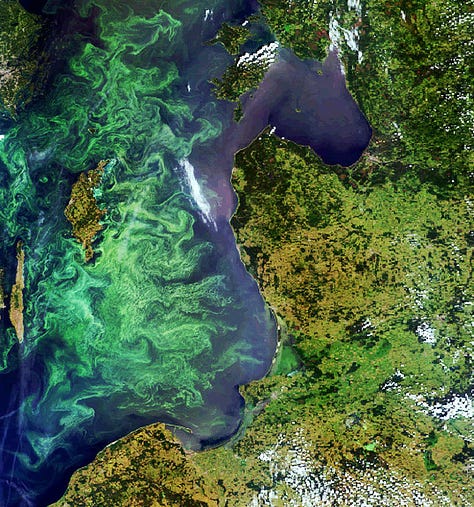

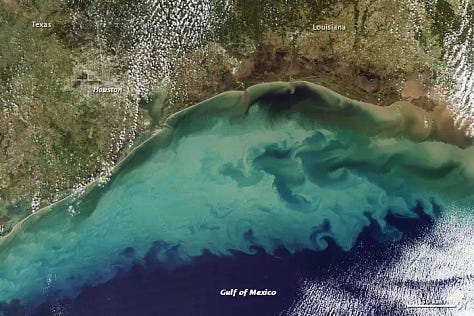
photo source / source / source
Pathogens (Blood, Water, Air)
Blood-borne
climate change increases range for mosquitos and therefore malaria, dengue, Zika (2023) - “Locally-transmitted cases of malaria have been identified in Florida and Texas, the first time in 20 years the disease has spread locally in the US.”
ticks' range is extending northward
mosquitos' breeding time window has increased
Waterborne
During 2021-2022, due to “the upsurge in extreme weather events linked to climate change, conflict, population displacement, and weakened healthcare systems”, world cholera cases more-than-doubled from 223k to 473k
“Schistosomiasis, spread by freshwater snails, affects more than 200 million people in many tropical regions of the world. It can cause stomach pain and irreversible consequences such as enlarged liver and cancer. Public health officials worry that deforestation, rapid urban sprawl, and changing rainfall patterns – such as Brazil’s devastating May floods – could dramatically shift the locations where the snails, and therefore the parasite, can thrive.”
Airborne
H5N1 death toll, since 2021 =
2024 H5N1 jumped to cows and then pigs
2024 In Uganda, tobacco farmers decimated chimps' food source (raffia palm) so the chimps have reverted to eating bat feces which contains 27 novel viruses. Scientists haven't confirmed whether the viruses persist in the chimps' guts
Prions
prion infection is …
highly contagious - It can persist for years in dirt or on surfaces, and victims tend to me asymptomatic for a while, so it spreads undetected
resists disinfectants, formaldehyde, radiation and heat (only exposure to >900 F for several hours neutralizes it)
incurable, fatal
2023 “zombie deer disease” reached Yellowstone
Antibiotic-resistant infections
as of 2022, over 25% of 258 rivers around the world were polluted with drugs to a toxic degree
antibiotic-resistant diseases breed in human conflict zones like the Russia-Ukraine invasion
Between 2016 and 2019, artemisinin-resistant malaria in some areas of East Africa rose from <1% to >20% of cases
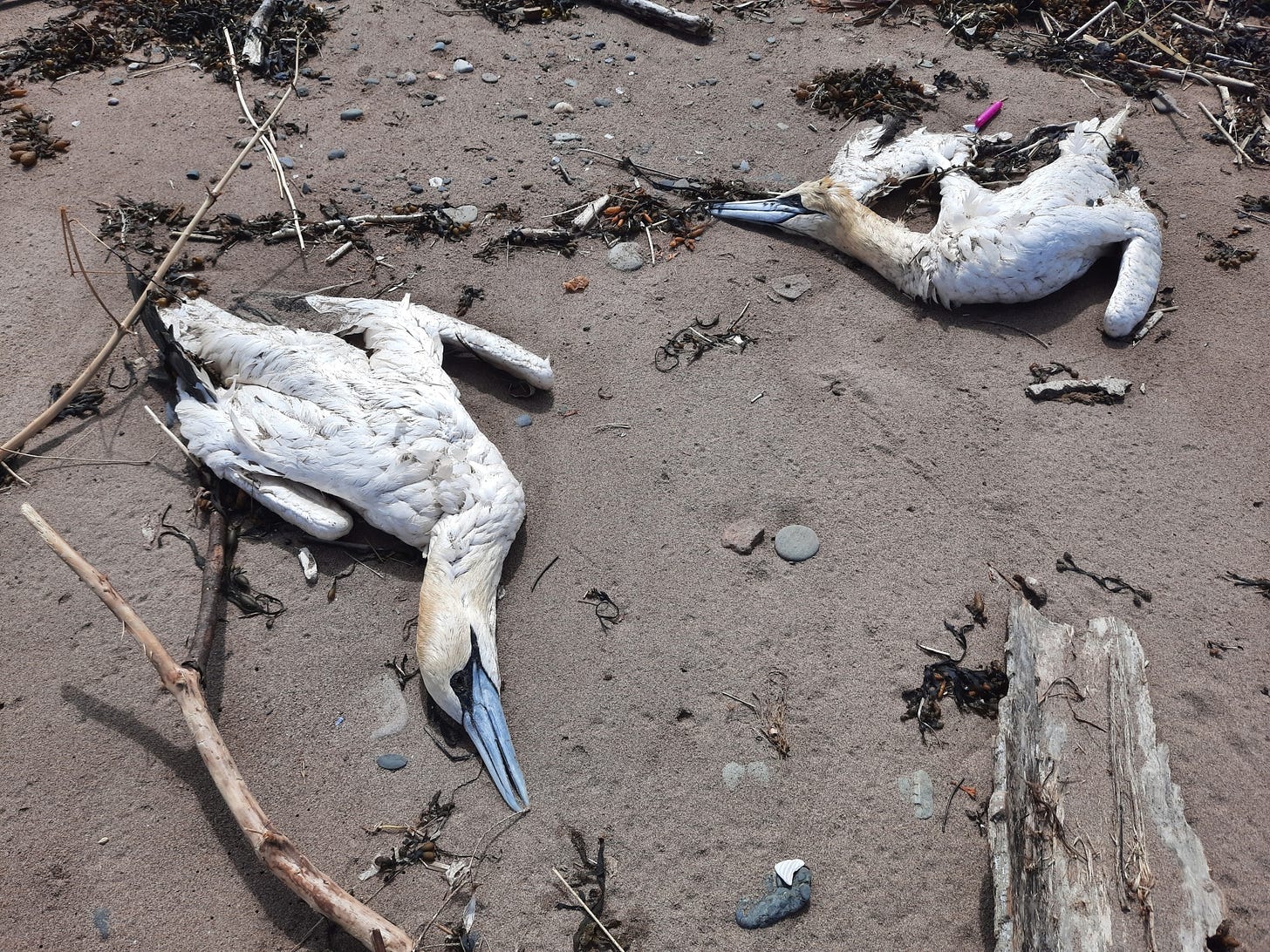
Ocean Acidification
CO2 emissions ➡️ ocean absorbs CO2 ➡️ ocean acidification (its pH decreases) ➡️ marine life has more difficulty forming shells and has less energy to reproduce
We may soon breach this Planetary Boundary too, making it the 7th area where we’ve entered the danger zone, out of the 9 metrics pictured at the very top of this post.
Ozone Hole
Some humans believe we cooperated internationally to solve this one. Nope! See NASA. And the hole lets through UVB rays that damage crops.
Climate Change (Finally!) & Marine Heatwaves
(The “pre-industrial average” that serves as the baseline was 13.79ºC, according to Berkeley Earth and NASA)
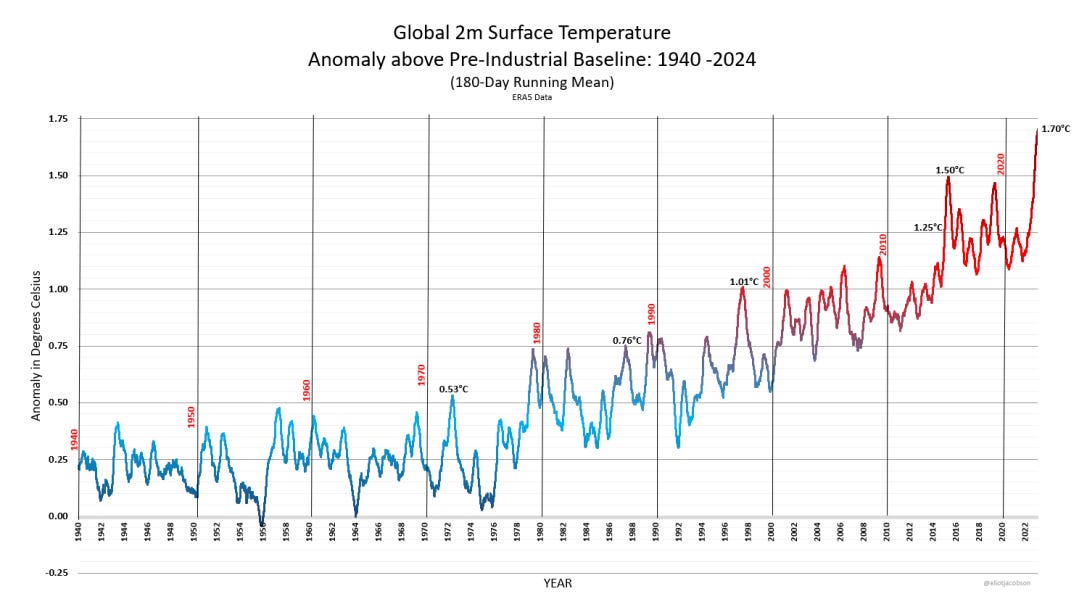
"Our predictions failed quite dramatically for the specifics of 2023, and if previous statistics don't work, then it becomes much harder to say what's going to happen in the future."
- Gavin Schmidt, the director of Nasa's Goddard Institute for Space Studies
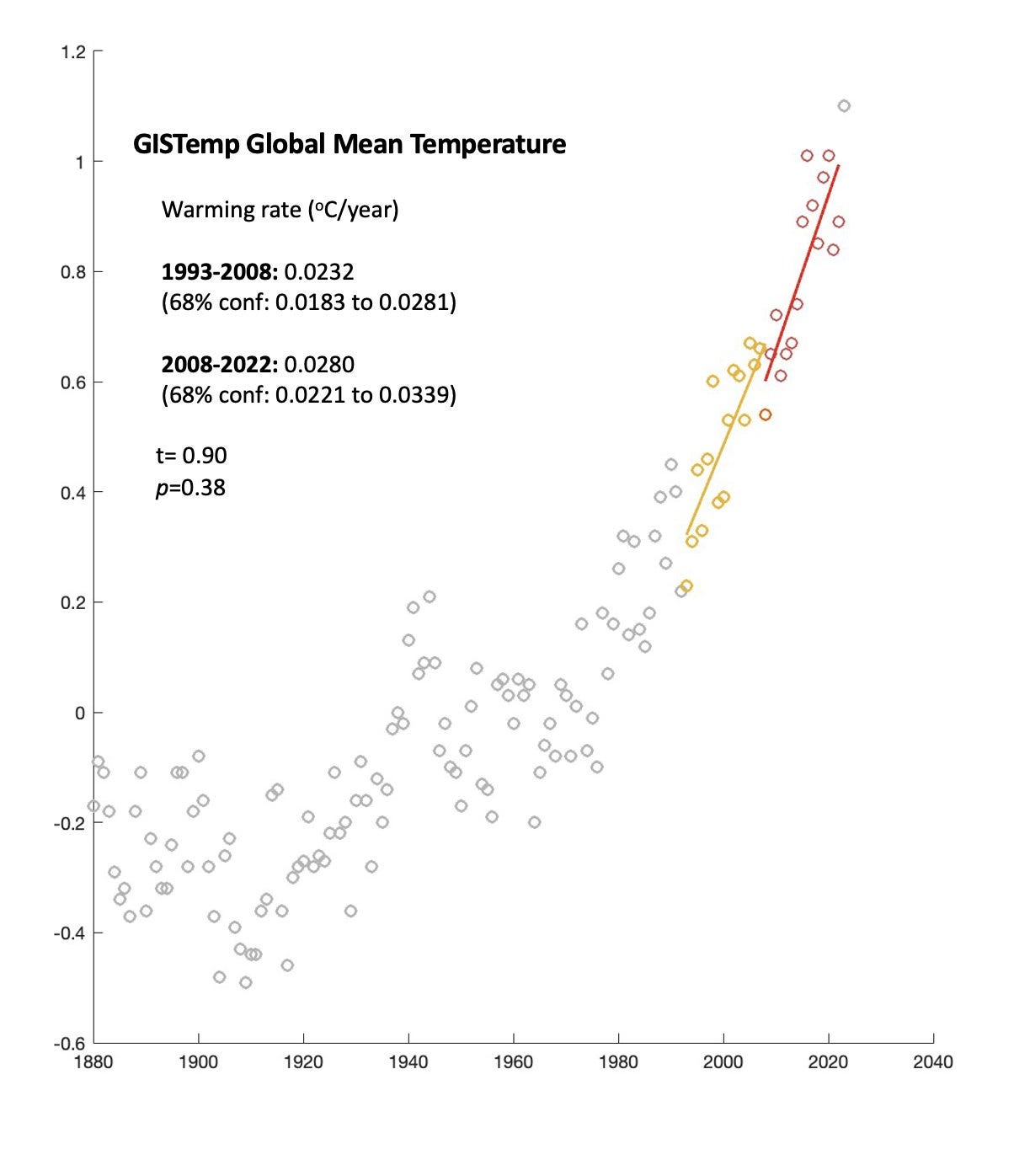
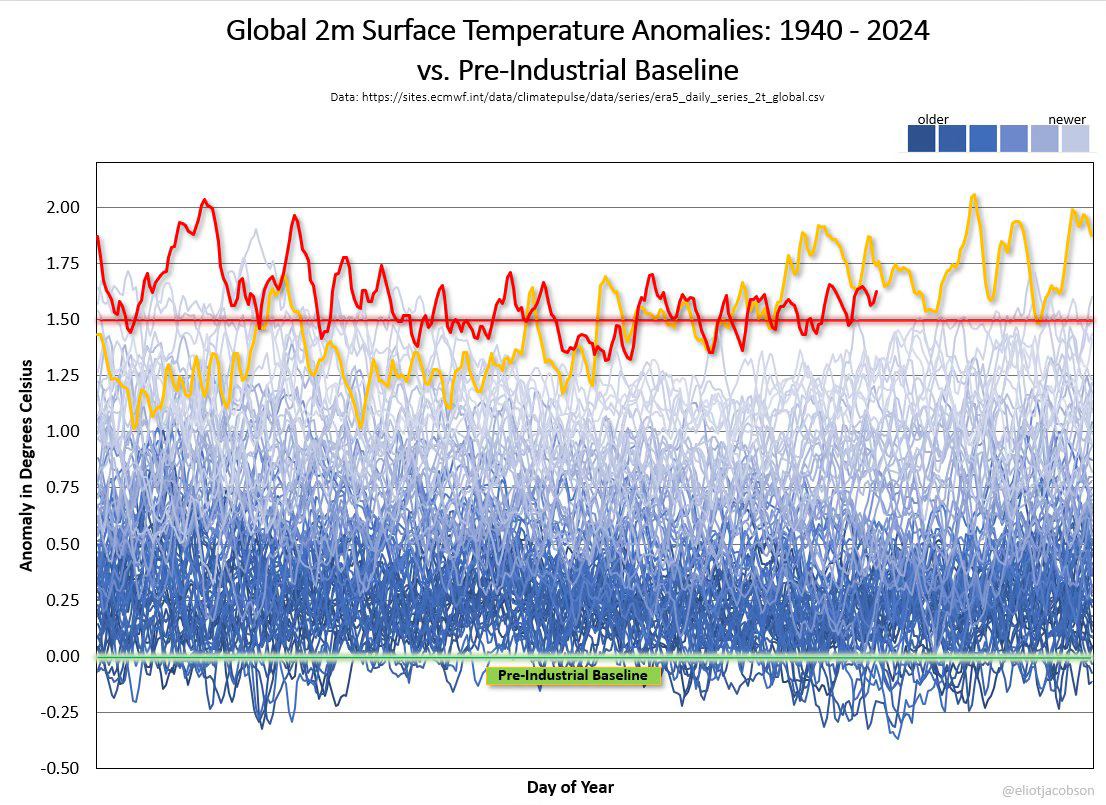
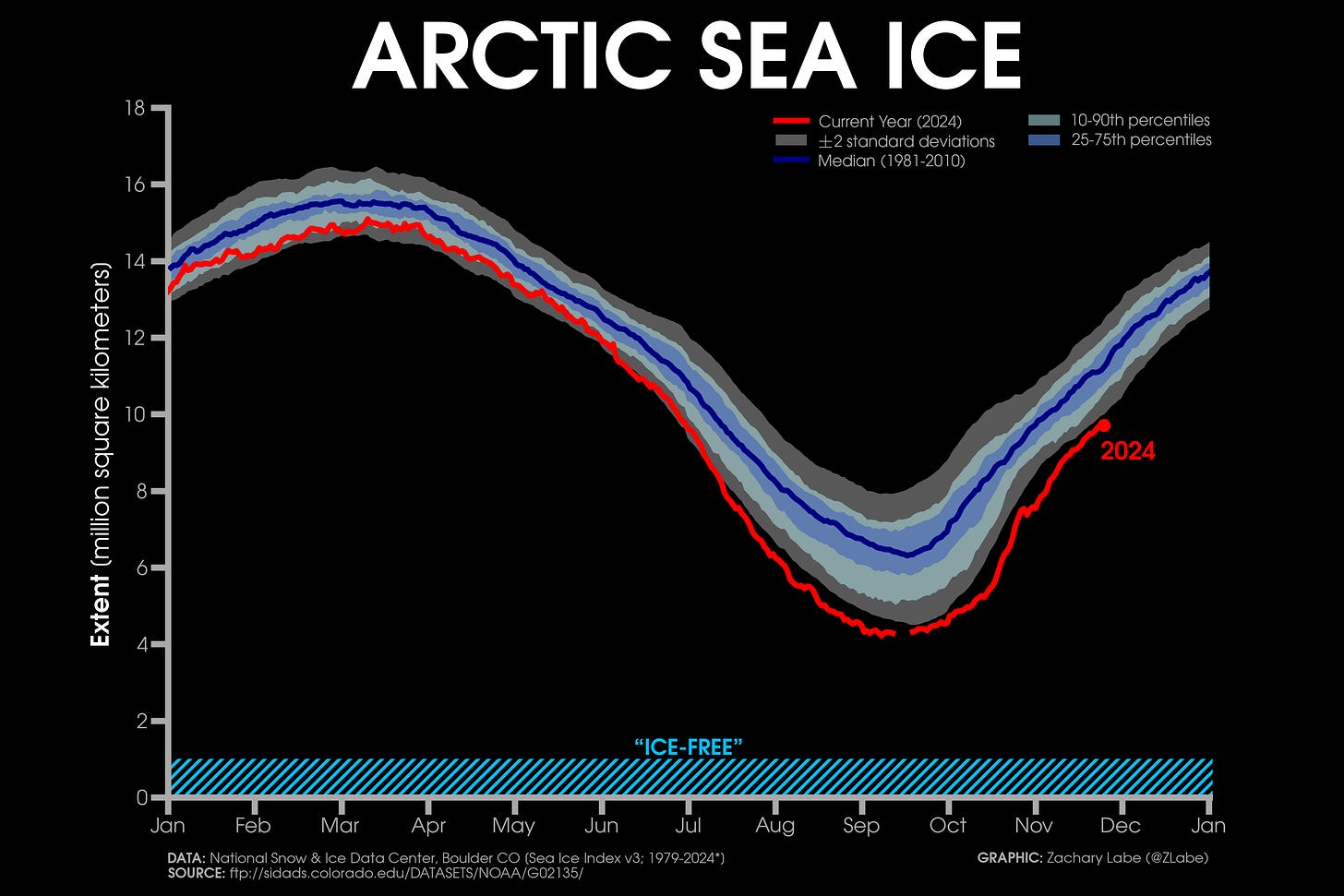
2024 “New UN weather agency chief says rate of global warming is speeding up”
Our situation is deteriorating so rapidly as to repeatedly surprised scientists:
Bulletin of the Atomic Scientists (2023): “Faster than forecast, climate impacts trigger tipping points in the Earth system”: “Recent research has shown that tipping points and cascades are already occurring, not at 1.5 or 2 degrees Celsius of warming, but right now.“
Guardian (2023): “Antarctica warming much faster than models predicted in ‘deeply concerning’ sign for sea levels”
CNN (2023): “The planet is heating up faster than predicted, says scientist who sounded climate alarm in the 1980s”
Financial Times (2024): “Caribbean sea sponges indicate faster than expected global warming, study says”: “Ocean temperature research sparks debate about baseline measure for climate change”
The IPCC determined that from 2019 forward, a budget of 400 Gt CO2 would give a 67% chance of staying below 1.5C, and 1150 would give a 67% chance of staying below 2C. In 2019-2024, global civilization emitted approximately 200 Gt yet we’re already passing 1.5C in 2024. (That was the average for the year. The UN uses 10-year average. With temperatures rising, the temperatures from the start of the range tend to be lower than more recent years, so it serves -even if not intentionally- to downplay heating.)
During the previous 15-year interval (1993-2008), we warmed (on-average) 0.0232 degrees Celsius per year. For the most recent 15 years, we warmed 0.028 degrees Celsius per year. At the “old” rate, it would’ve taken 43.1 years for the global average to rise another 1C. At the newer rate, it’d take 35.7 years to add 1C. We “shaved off 8 years” (in a bad way) and could witness the time between fraction-of-a-degree milestones continue to shrink.
Climate studies often refer to the Representative Concentration Pathways (RCPs). “RCP 2.6” is the best-case scenario: warm +1.8C by 2100. “RCP 8.5” is the worst case: +4.3C by 2100. The worst-case scenario “comes closest to capturing the effects ‘of both historical emissions and anticipated outcomes of current global climate policies, tracking within 1 percent of actual emissions.’”
The temperature rise might slow down if:
oil production plateaus and declines (maybe starting in 2035?)
various factors cause significant human population decline
The temperature rise might speed up due to:
Loss of aerosol masking effect, leading to “Termination Shock” - likely a big current factor
Tipping Points (distinct thresholds) and Feedback Loops (less distinct)
Humans (faced with liquid-hydrocarbon decline and “green” energy’s shortcomings, and desperate for industrial energy) turn to (“dirtier”) coal and firewood/deforestation
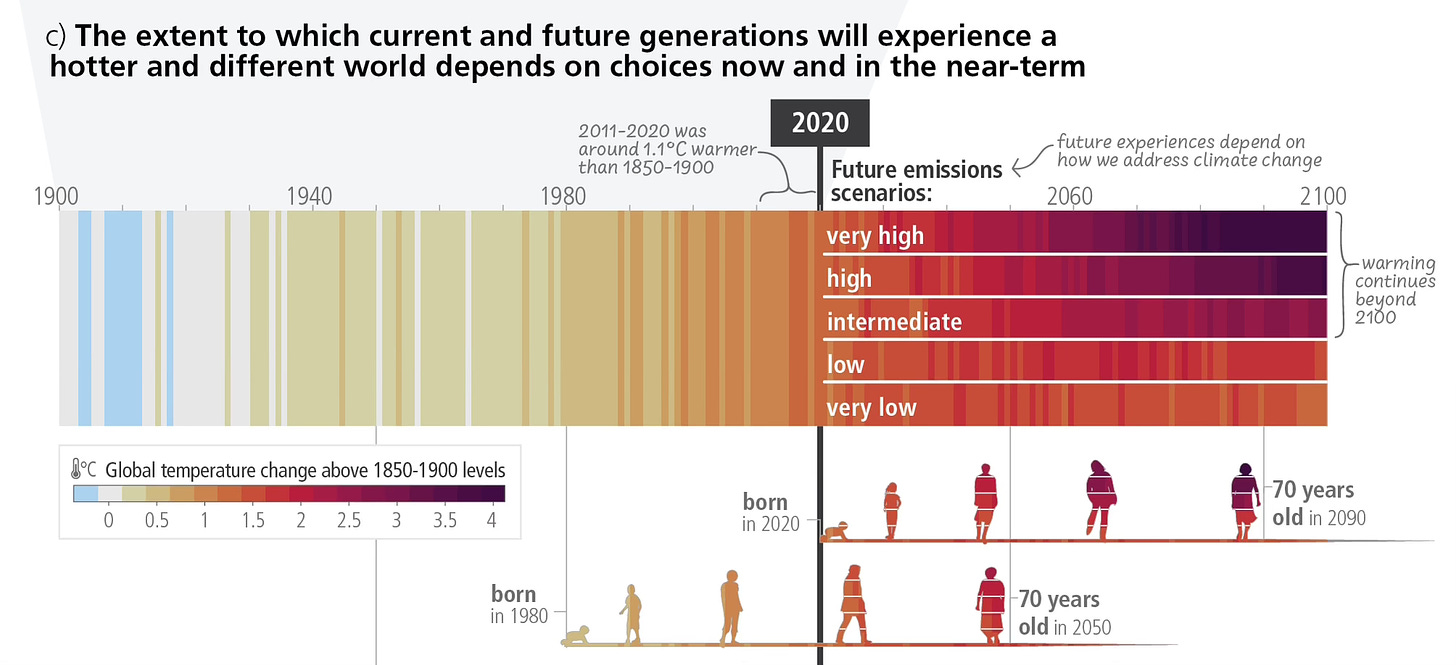
2024 “The Atlantic Ocean is unusually warm right now. Scientists are sounding the alarm.” - a great summary of the causes and consequences of marine heat waves
“2023’s record-high North Atlantic sea surface temperature and record-low Antarctic sea ice cover extremes were similar to what we might expect to see in a world that had reached the 3°C threshold of global warming. While many factors, including El Niño, have been suggested as the main drivers of last year’s extremes, the authors believe that these explanations may be insufficient.”
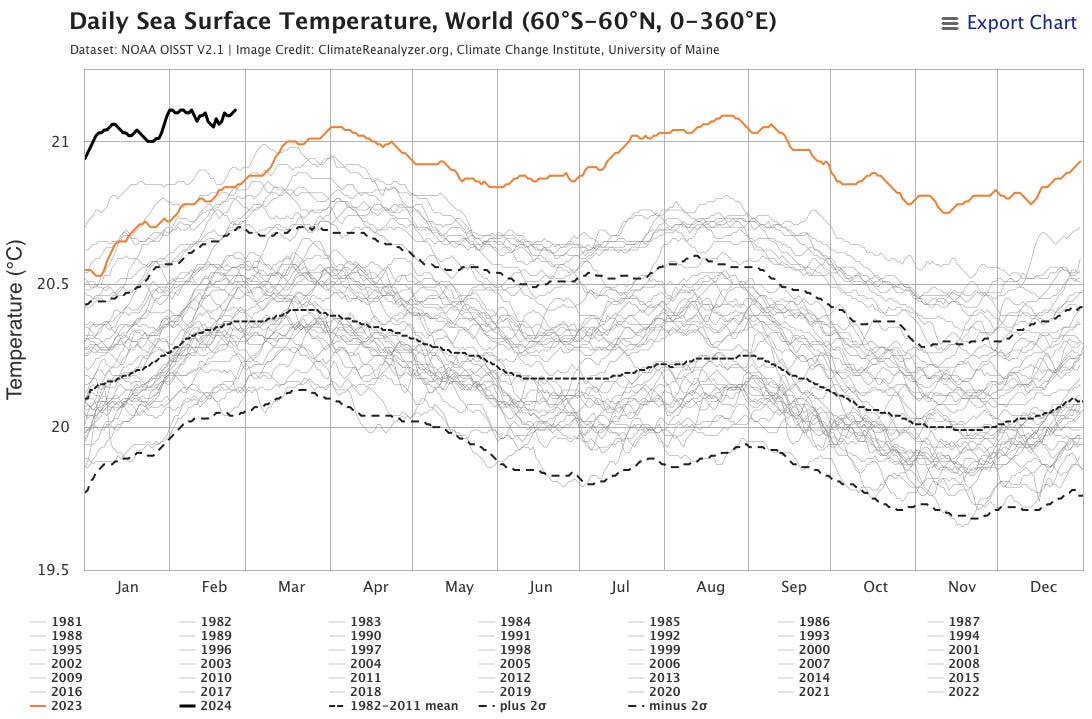
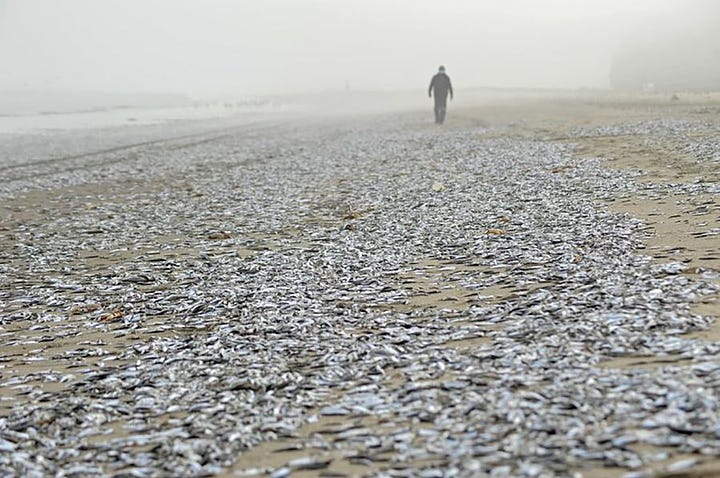
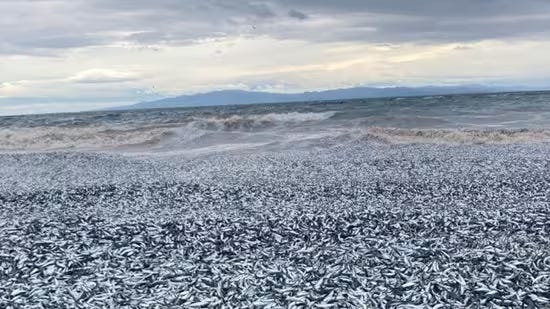
photo source, source
Declines in plankton yield disproportionate declines in fish
Record North Atlantic heat sees phytoplankton decline, fish shift to Arctic -
“As marine heat waves there have worsened over the years, populations of phytoplankton, the base of the oceanic food chain, have declined in the Eastern North Atlantic. North Atlantic fish species are moving northward into the Arctic Ocean in search of cooler waters, creating competition risks with Arctic endemic species and possibly destabilizing the entire marine food web in the region.”
2022-2023 saw 1000 seals dead (stillbirths and pups) as marine heatwaves and overfishing diminish their food source -
“New Zealand fur seals eat 46 species of fish, 18 cephalopod species and so the fact they are still starving… with that very diverse diet, is very troublesome”.
The study notes that this is affecting seabirds, too. “An emaciated … penguin was found … It breeds on the Sub Antarctic Islands some hundreds of km from New Zealand shores… Essentially we are seeing the start of an eco-system collapse so that's really grim news”
From 2014 to 2016, maximum sea temperatures in the NE Pacific were 3-6C above average. “This left fewer nutrients for phytoplankton, the plants at the base of the marine food web. The impacts cascaded across the ecosystem, leaving less food for everything from sardines to seabirds to sea lions.” Between 2013-2021, the humpback whale population dropped by 7,000. A new study suggests it was due to nutritional stress.
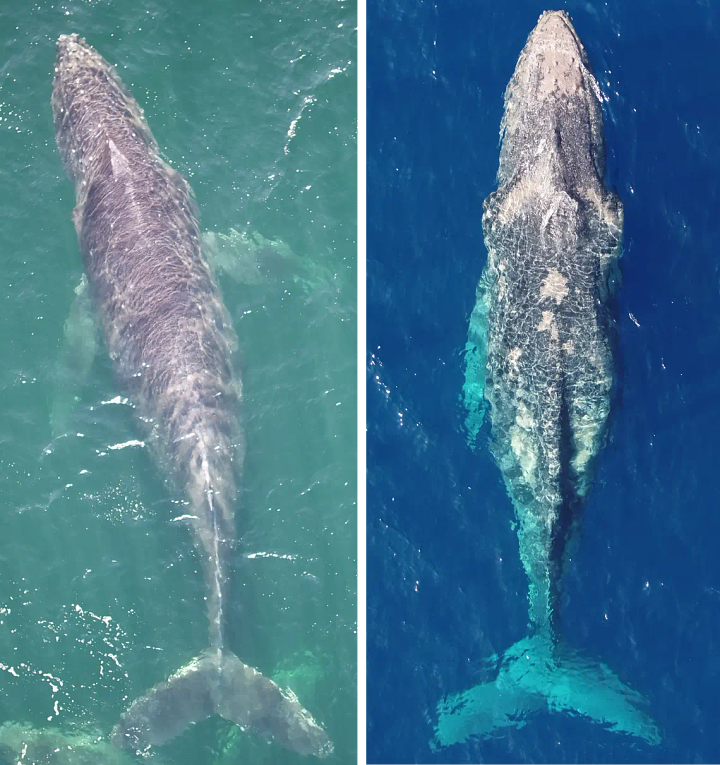
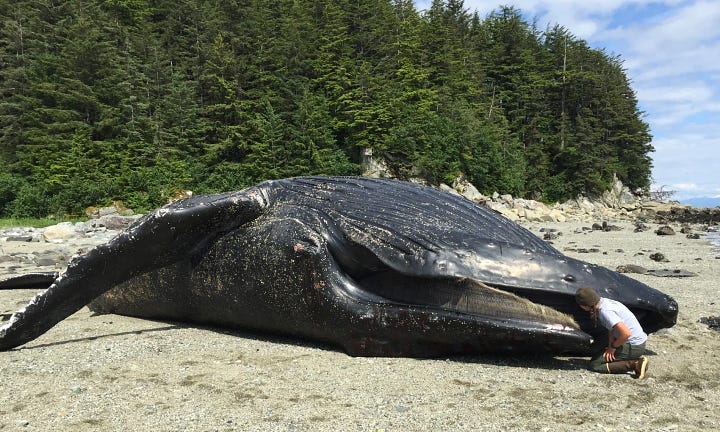
photo source
Climate Tipping Points
Below is video (from 2008) warning about tipping points - whoops!
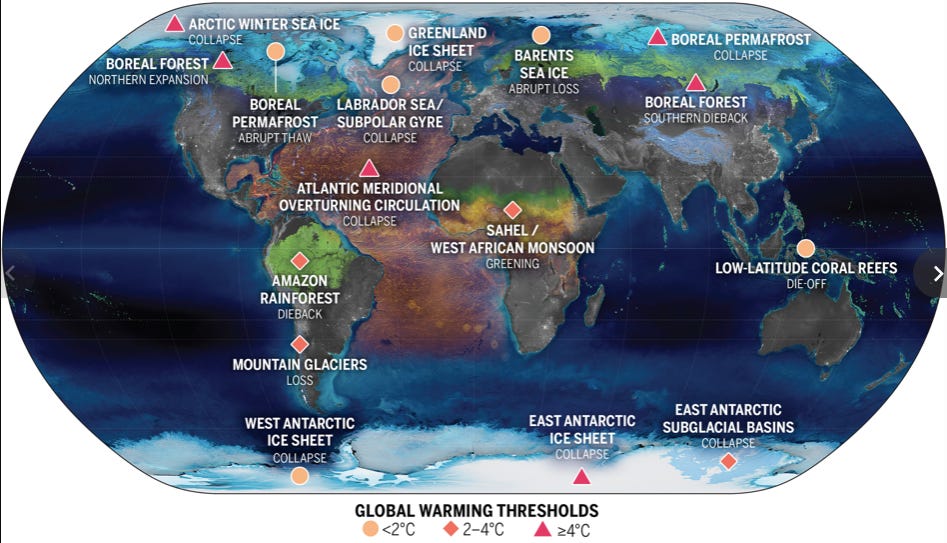
2023 “Earth on verge of five catastrophic climate tipping points, scientists warn” - We’re already positioned to trigger 5 tipping points. Past +1.5C, another 3 become at-risk.
Amazon rainforest dieback (“Land System Change” is also a Planetary Boundary)
Boreal forests dieback (“Land System Change” is also a Planetary Boundary) - wildfires are burning through boreal forests faster than those forests can grow back
Coral reefs dieback - At +1.5°C (which we maybe have already passed - The 2023 global annual average was 1.54 ± 0.06 °C above the 1850-1900 average, according to Berkeley Earth), 99% of reefs die. At +2°C, which we’re on track to hit in the 2030s, 100% of reefs would be decimated beyond recovery. "An estimated 25%of all marine life ... are dependent on coral reefs at some point in their life cycle." (EPA)
Permafrost thaw
Albedo loss / Blue Ocean Event “BOE” – less ocean ice means faster heating oceans
from 2014 to 2019, Arctic summer saw a 20-35% decrease in reflectivity
2023 Antarctic sea ice at record low (*“there is some evidence of a similar sudden swing from high levels of sea ice to very low in photographs from mid-1960s satellites”)
2024 Antartica was 50F hotter than normal
Atlantic Meridional Overturning Circulation (AMOC) slowdown
2023 “A crucial system of ocean currents is heading for a collapse that ‘would affect every person on the planet’” some time this century / the study
2024- Atlantic Ocean circulation nearing ‘devastating’ tipping point - “already on track towards an abrupt shift, which has not happened for more than 10,000 years”, “the system is being eroded by the faster-than-expected melt-off of Greenland’s glaciers and Arctic ice sheets”, “a slow decline can lead to a sudden collapse over less than 100 years”, “the changes would hit 10 times faster than now, making adaptation almost impossible” (“almost”?) / the study
Extreme Heat, Wildfires, Catastrophic Weather
The Jet Stream (an atmospheric phenomenon, whereas the AMOC is marine) is speeding up and could move permanently by 2060
Wet bulb temperature is a measurement that takes into account heat and humidity. (Here’s a wet bulb calculator.) “Threshold wet bulb temperature” is a term for conditions where sweat can no longer cool the human body to a reasonable temperature. If a person experiences this weather for 6 hours, it will kill them. One study found that this threshold is 35C. A 2022 study found that it might be 31.5C.
The heat index (how hot it feels) is rising faster than the actual temperature is. For example, the month of March in Rio de Janeiro typically sees a high of 87ºF. But in March 2024, Rio hit 104ºF, and the humidity made it feel like 144.1ºF.
“Extreme heat and surging CO2 levels impair decision-making, diminish problem-solving abilities, and short-circuit our capacity to learn… Researchers estimate that the disparate effects of hot school days –disproportionately felt in poorer school districts without access to air conditioning and home to higher concentrations of non-white students– account for something on the order of 5% of the racial achievement gap in the US… Dementia-related hospitalizations rise with temperature. Warmer weather worsens the symptoms of neurodegeneration as well… Early pregnancy exposure to extreme heat is associated with a higher risk of children developing neuropsychiatric conditions such as schizophrenia and anorexia.” (The Guardian, 2024)
wildfires release harmful particles one-tenth the width of a hair strand; enter our bloodstream; cause inflammation, asthma, heart attack, stroke, cancer - EPA, NPR, Stanford
2022 Extreme heat in Pakistan is causing miscarriages
2023 Hurricane Otis marks the first time in recorded history that the eastern Pacific has had such a strong hurricane make landfall and continue with Category-5 intensity
2024 Wisconsin saw its first February tornadoes on record - the season is usually April-September
2024 Pakistan “doctors treat thousands of heatstroke victims”
2024 Hurricane Beryl is the earliest Category 5 ever (previous record was set in 2005 by Hurricane Emily, which formed July 16th)
2024 Extreme heat during hajj kills over 1300 pilgrims
2024 Brazil faced extreme flooding (“‘I’ve seen things no one should go through’: the overwhelming scale of loss in Brazil’s floods” … “In the state of Rio Grande do Sul, authorities are struggling to find shelter for half a million displaced people as a health crisis looms”) AND immense wildfires (“During Brazil’s worst drought, wildfires rage and the Amazon River falls to a record low”)
2024 Africa’s Sahara Desert received 6x its average annual rainfall in 30 days - killing at least 1000 people and displacing millions
2024 Portugal and Romania - “Entire city evacuated after floods, 7 die in wildfires as extreme weather sweeps Europe”
2024 Antarctic heat wave sent temperatures 50 degrees above what they should be
